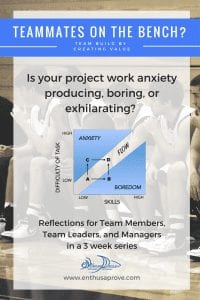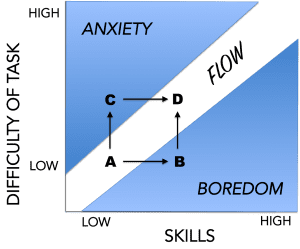 In the last post, I shared with you my time as a soccer team bench warmer. What kept me on the bench wasn’t that different than what keeps your teammates (or yourself) on the bench of your project (i.e. not fully engaged with the work). This can happen for a myriad of reasons. Depending on your team role (team member, team leader, and manager), you likely see a different aspect of this, so we gave you role-specific insights into how to build connection to get others (or yourself) off the bench.
In the last post, I shared with you my time as a soccer team bench warmer. What kept me on the bench wasn’t that different than what keeps your teammates (or yourself) on the bench of your project (i.e. not fully engaged with the work). This can happen for a myriad of reasons. Depending on your team role (team member, team leader, and manager), you likely see a different aspect of this, so we gave you role-specific insights into how to build connection to get others (or yourself) off the bench.
Now what?!?! That’s what we are discussing here. In building the connection to purpose and each other, you have to channel that energy towards something. It’s a fluid back and forth dance between connection and creation that gets people engaged with the work. That’s what we call the CREATE step. We have people taking steps off the bench, but now they are wondering what to do. Now it’s time to PLAY in the game!
What does that look like on a project?
- Team Member: It is finding a way to use my expertise and experience in the project work. When there is a good fit, this gives us satisfaction that we are needed and valuable to the team. When there isn’t a good fit…hang with us…ideas to come below. Keep reading.
- Team Leader: You have to connect the talent on the team to the needs of the project. There isn’t always a perfect match, which gives a great opportunity to find new ways to use the talents of the team to do what is needed.
- Manager: You are looking for creative ways to utilize the talents of your people and build on their skills for the future. Stretch assignments or using tried-and-true expertise, either way a manager serves his/her people best when the team’s talents are utilized and stretched to grow.
HOW?!?!
We would suggest a framework by Mihaly Csikszentmihalyi’s concept of Flow. Don’t worry, it’s simpler to understand than it is to say his name.
What is Flow? It’s that joy you experience when your skills match the task at hand, with just the right mix of “I know how to do this” and “there’s a bit of a challenge to this.” Flow is when you’re playing at your best in a game that requires you to play your best. In other words, you’re in the flow.
Conversely,
- When the task is simpler than your skills, you can do it, but…you’ll easily get bored.
- When the task is requires more than you have skills for, you get frustrated, or, when you look at the need to do this seemingly too hard a task, you get anxious.
There are several graphics that help explain this flow principle; we are going to use the simplest version here.
Here’s wonderful illustration of this FLOW principle (that a longtime mentor told me). When we first learn piano, we can’t wait to show our parents how we can play Mary Had A Little Lamb. But then our skills increase (we move from ‘A’ to ‘B’) and playing that lamb song is BORING. Conversely, the music teacher flips to the back of the book and assigns us Beethoven’s Ode to Joy (moving us from ‘A’ to ‘C’)…and despite the uplifting lyrics, we are frozen in anxiety because our piano skills aren’t there yet. When our skills do increase (moving us from ‘C’ to ‘D’), we are yet again running to ask our parents to listen to a wonderful rendition.
MANAGERS and TEAM LEADERS
This is the delicate dance we do to match talents to tasks, which is never a perfect fit. This Flow model is a communication tool for that. We can show the whole team where the tasks are outside of the Flow and explain why every project has those things you just have to do. My Grandmother used this persuasion with me and now I rehearse every time I’m changing a stinky diaper.
Every team needs every part of the task done. It’s not about fun or fair; it’s about being a team. Imagine if after a quarterback fumbles, the guard looks at the ball on the ground and leaves it there. He states that his job is only to block, not run the ball. (Though in football this would cause outrage, we see this all the time on projects…hmm.)
This doesn’t mean we just say “suck it up and do it.” (Not a team engagement building move, BTW) It’s about going back to Connect…and connection of each person to each other and the purpose.
We could stand there and call the fumbling QB a klutz or we could just jump on the ball. You, as a leader, need to have everyone so well connected that no matter the flow, each person is ready to jump on the ball. That said, an often fumbling QB won’t translate into guards being able to suddenly be running backs…there will be anxiety. When there’s the mismatch of skills and task difficulty, this is where a great manager and team leader shines. Here’s some ideas.
When the task is:
- Boring (area B). Look for ways to change the attitude around the task. We all inherently want to create value, so we try to show the value and decrease the boredom. When when the task doesn’t look like much creating, here’s a few things you can do.
- Reinforce Value to the Mission and Team.
- Make it quick. Look for efficiency opportunities to get through it without delay.
- Get others involved to get connection benefit. The idea is “If we have to do it, doing it together is better.”
- Anxiety (area C). For those above the flow, we look for ways to change the belief around his/her capability (because you are asking people to do something they haven’t yet learned). Get some training for them (formal or informal) and be a great encourager. Your goal is to build belief that they CAN do it, nudging them into flow.
TEAM MEMBERS
If you think that this is all in the hands of the managers and team leaders, think again! You control your own attitude. Many times we artificially cast ourselves out of the Flow lane by how we see the situation.
When we think we are in Anxiety (area ‘C’), we only see how we can’t do the task, instead of focusing on how we can learn the task. So many times a little time searching for the answer online can reveal a quick video or blog post that solves the problem in minutes. Try it. I’ve learned how to fix my 1966 mustang, troubleshoot my website issues, and make excellent brownies with a quick search. There’s an answer out there to teach you what you need to know.
Similarly, when we are in Boring (area ‘B’), we spend our time wishing we were doing something more challenging, instead of seeing that we can speedily do this task opening up perhaps something else the team, or we, can do. Sometimes the only job left is changing the stinky diaper. Well, just pinch your nose and focus on transforming crying into giggling.
The Challenge
Projects require us to do new things. Projects require us to respond to unforeseen needs (which might seem below our pay grade). A team that has built connection to a great purpose and each other can quickly get disillusioned when the real creating starts. They may hold back, not contributing, which may look like laziness.
But if we put on our W. Edwards Deming hat, or if we put on our Senge Systems Thinking hat (I wouldn’t wear that one to a party), we know that immediately blaming the person is a low probability strategy. In Deming terms, 90% of the issues are due to the management, or the process. In System Thinking terms, systems drive behaviors. I’d even suggest that using the lazy term may just be another manifestation of the Fundamental Attribution Error.
The bottom line is that this is our challenge to lead through. Staying in thinking lazy, boring, or anxious, i.e. blaming the person, is just defaulting on our job as Managers, Team Leaders, and even Team Members. Our job is to lead so that we, the team, will create value.
Stay tuned for our next post, to include suggestions for getting teammates off the bench and contributing value.





